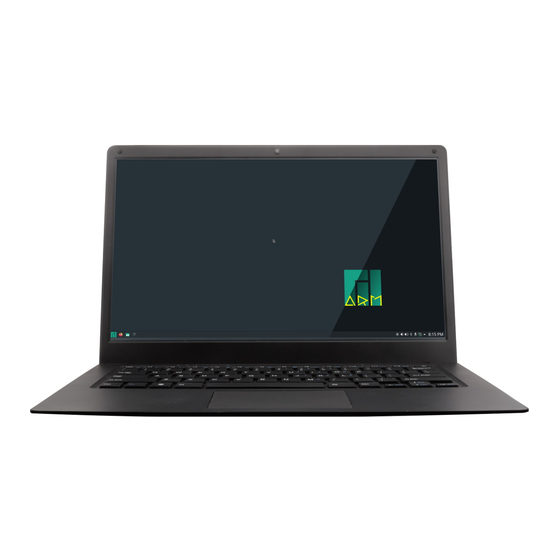
Advertisement
User Guide
The Pinebook Pro is a Linux and *BSD ARM laptop from
PINE64
It is built to be a compelling alternative to mid-ranged Chromebooks that people convert
into Linux laptops. It features an IPS 1080p 14" LCD panel, a premium magnesium alloy
shell, high capacity eMMC storage, a 10,000 mAh capacity battery, and the modularity
that only an open source project can deliver.
Key features include: the RK3399 SOC; USB-C for data, video-out and power-in (3A 5V);
privacy switches for the microphone, BT/WiFi module, and camera; and expandable
storage via NVMe (PCIe 4x) with an optional adapter.
The Pinebook Pro is equipped with 4GB LPDDR4 system memory, high capacity eMMC
flash storage, and 128Mb SPI boot Flash. The I/O includes: 1x micro SD card reader
(bootable), 1x USB 2.0, 1x USB 3.0, 1x USB type C Host with DP 1.2 and power-in, PCIe
4x for an NVMe SSD drive (requires an optional adapter), and UART (via the headphone
jack by setting an internal switch).
The keyboard and trackpad both use the USB 2.0 protocol. The LCD panel uses eDP
MiPi display protocol.
Many different Operating Systems (OS) are freely available from the open source
community and partner projects. These include various flavors of Linux (Ubuntu, Debian,
Manjaro, etc.) and *BSD.
Using the optional NVMe adapter
The optional NVMe adapter allows the use of M.2 cards that support the NVMe standard,
(but not SATA standard).
Installing the adapter
The v2.1 SSD adapter that is shipped with the initial Pinebook Pro batches had
significant issues. A repair kit will be shipped to address those issues.
(If necessary, they can be modified to work. There is
an unofficial tutorial on the
forums
describing these modifications.)
Using as data drive
As long as the kernel in use has both the PCIe and NVMe drivers, you should be able to
use a NVMe drive as a data drive. It can automatically mount when booting from either
the eMMC or an SD card. This applies to both Linux and FreeBSD, using the normal
partitioning and file system creation tools. Android and Chromium OS require testing.
Using as OS root drive
It is not possible to boot directly off an NVMe drive. The SoC does not include the NVMe
boot code, so the NVMe is not in the SoC's boot order.
Advertisement
Table of Contents

Summary of Contents for PINE64 Pinebook Pro
- Page 1 (but not SATA standard). Installing the adapter The v2.1 SSD adapter that is shipped with the initial Pinebook Pro batches had significant issues. A repair kit will be shipped to address those issues. (If necessary, they can be modified to work. There is...
-
Page 2: Troubleshooting Guide
'Service Guides for Pinebook' you can find instructions guides concerning disassembly of: Note: The installation process on Pinebook Pro similar to 14" Pinebook Note: The installation process is the reverse order of removal guide 14″ Pinebook Lithium Battery Pack Removal Guide •... - Page 3 It's possible that your eMMC is empty from the factory. Simply create a bootable SD • card and see if your Pinebook Pro boots. If so, you can then write an OS image to the eMMC. Pinebook Pro won't boot when using UART console cable If you're using the UART cable sold on the Pine Store, you may want to see if it boots •...
-
Page 4: Bluetooth Issues
USB docks & USB C alternate mode video The Pinebook Pro uses the RK3399 SoC, (System on a Chip). It supports a video pass through mode on the USB C port called alternate mode, using DisplayPort. This DisplayPort would come from the same GPU as the builtin LCD is displaying. Here are some selection criteria for successfully using the USB C alternate mode for video: The device must use USB C alternate mode DisplayPort. - Page 5 is located) in place using the short screws in the front left and right corners. Then proceed to pop in the bottom panel into place. Secure the bottom section (where hinges are located) by screwing in the left and right corners. Then screw in the remaining screws and run your finger though the rim on the chassis to make sure its fitted correctly.
-
Page 7: Cpu Architecture
Bootable Storage The Pinebook Pro is capable of booting from eMMC, USB 2.0, USB 3.0, or an SD card. It cannot boot from USB-C. The boot order of the hard-coded ROM of its RK3399 SoC is: SPI NOR, eMMC, SD, USB OTG. -
Page 8: System Memory
Storage Memory: • 64GB eMMC module, can be upgraded to a 128GB eMMC module. (The initial • PINE64 community build version shipped with a 128GB eMMC.) eMMC version 5.1, HS400, 8 bit on RK3399 side • Battery Lithium Polymer Battery (10,000 mAH) •... -
Page 9: Video Out
14.1" 1920x1080 IPS LCD panel • Video out USB-C Alt mode DP • Up to 3840x2160 p60, dependant on adapter, (2 lanes verses 4 lanes) • Audio 3.5mm stereo earphone/microphone plug • Build in stereo speakers • Network WiFi: • 802.11 b/g/n/ac •... - Page 10 FCC RF Exposure Information and Statement the SAR limit of USA (FCC) is1.6 W/ kg averaged over one gram of this Device 14″ PINEBOOK Pro LINUX LAPTOP (FCC ID: 2ANV3-PINEBOOKPRO) has been tested against this SAR limit. SAR information on this can be viewed on-line at http://www.fcc.gov/oet/ea/fccid/.
Need help?
Do you have a question about the Pinebook Pro and is the answer not in the manual?
Questions and answers